The Stranger (1946 film)
7.6 /10 1 Votes
Music director Bronislaw Kaper Country United States | 7.6/10 IMDb Genre Crime, Drama, Film-Noir Duration Language English | |||||||||||||||||||||||||||||||||
 | ||||||||||||||||||||||||||||||||||
Writer Anthony Veiller (screenplay), Victor Trivas (adaptation), Decla Dunning (adaptation), Victor Trivas (story) Initial release August 25, 1946 (United Kingdom) Cast (Federal Agent Wilson), (Mary Longstreet), Orson Welles (Charles Rankin), (Judge Adam Longstreet), (Noah Longstreet), (Konrad Meinike)Similar movies Back to the Future , Kiki's Delivery Service , The Third Man , The Night of the Hunter , Double Indemnity , Inside Man Tagline The Most Deceitful Man A Woman Ever Loved ! | ||||||||||||||||||||||||||||||||||
The Stranger is a 1946 American film noir starring Edward G. Robinson, Loretta Young, and Orson Welles. It was Welles's third completed feature film as director. A drama about a war crimes investigator who tracks a high-ranking Nazi fugitive to a New England town, it is the first Hollywood film to present documentary footage of the Holocaust. The original story by Victor Trivas was nominated for an Academy Award. The film entered the public domain when its copyright was not renewed.
Contents
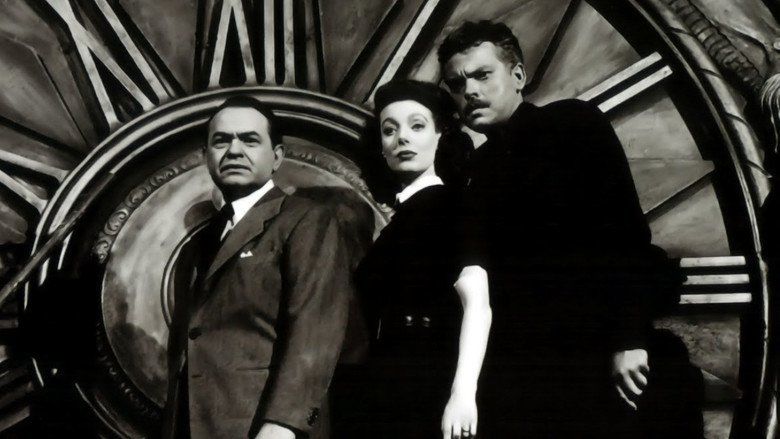
The stranger 1946 orson welles
Plot

In 1946, Mr. Wilson (Edward G. Robinson) of the United Nations War Crimes Commission is hunting for Nazi fugitive Franz Kindler (Orson Welles), a war criminal who has erased all evidence which might identify him, with no clue left to his identity except "a hobby that almost amounts to a mania—clocks."

Wilson releases Kindler's former associate Meinike (Konstantin Shayne), hoping the man will lead him to Kindler. Wilson follows Meinike to the United States, to the town of Harper, Connecticut, but loses him before he meets with Kindler. Kindler has assumed a new identity and is known locally as "Charles Rankin," and has become a prep school teacher. He is about to marry Mary Longstreet (Loretta Young), daughter of Supreme Court Justice Adam Longstreet (Philip Merivale), and is involved in repairing the town's 300-year-old Habrecht-style clock mechanism with religious automata that crowns the belfry of a church in the town square.
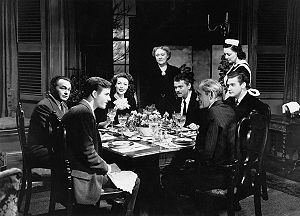
When Kindler/Rankin and Meinike do meet, Meinike, who is repentant, begs Kindler to confess his crimes. Instead, Kindler strangles Meinike, who might expose him.
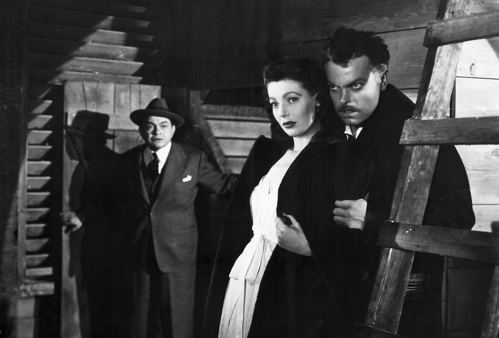
Eventually, Wilson deduces that Rankin is Kindler, but not having witnessed the meeting with Meinike, he has no proof. Only Mary knows that Meinike came to meet her husband. To get her to admit this, Wilson must convince her that her husband is a criminal—before Rankin decides to eliminate the threat to him by killing her. Rankin's pose begins to unravel when Red, the family dog, discovers Meinike's body. To further protect his secret, Rankin poisons Red.

Meanwhile, Mrs. Rankin begins to suspect her husband, but she is too blinded by love to accept the facts. She is torn between her desire to learn the truth concerning her husband as a possible murderous monster and the idea of helping him create his new life. Mr. Wilson shows her graphic footage of Nazi concentration camps and explains how Rankin, as Kindler, developed the idea of genocide.
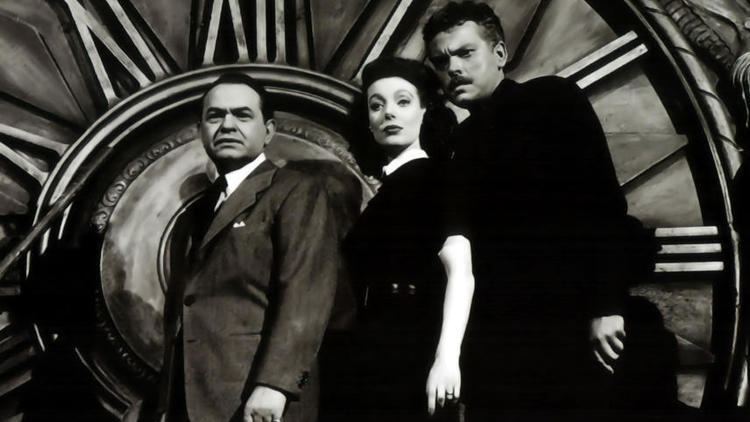
Not until Mary discovers Rankin's plot to kill her does she finally relent. In a tense moment, she dares Rankin to kill her. Rankin tries to, but he is prevented by Wilson and Mary's brother Noah (Richard Long). Pursued by them, he flees into the church belfry, is impaled by the clock mechanism he has labored to repair, and falls to his death.
Cast

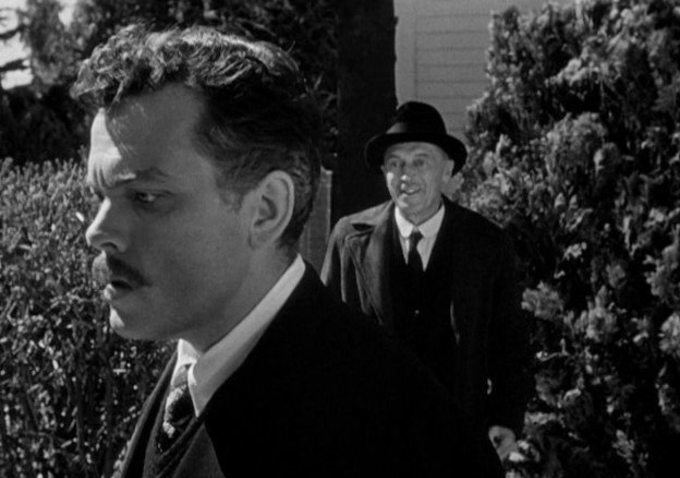
Contemporary news items about the production add uncredited and unconfirmed cast members Neal Dodd, Nancy Evans, Fred Godoy, Joseph Granby, Ruth Lee, Lillian Molieri, Gabriel Peralta, Gerald Pierce, Robert Raison, Rebel Randall, Johnny Sands and Josephine Victor.
Production
Produced by Sam Spiegel (who then billed himself as S. P. Eagle), The Stranger was the last International Pictures Production distributed by RKO Pictures. Filming took place from late September to November 21, 1945, at Samuel Goldwyn Studios and Universal Studios. The film's musical score is by Bronisław Kaper.
Spiegel initially planned to hire John Huston to direct The Stranger. When Huston entered the military, Welles was given the chance to direct the film and prove himself able to make a film on schedule and under budget—something he was so eager to do that he accepted a disadvantageous contract. In September 1945 Welles and his wife Rita Hayworth signed a guarantee that Welles would owe International Pictures any of his earnings, from any source, above $50,000 a year if he did not meet his contractual obligations. He also agreed to defer to the studio in any creative dispute. The Stranger was Welles's first job as a film director in four years.
Editor Ernest J. Nims was given the power to cut any material he considered extraneous from the script before shooting began. "He was the great supercutter," Welles said, "who believed that nothing should be in a movie that did not advance the story. And since most of the good stuff in my movies doesn't advance the story at all, you can imagine what a nemesis he was to me."
For directing and acting in The Stranger, Welles was to receive $2,000 a week plus $50,000 when the film was completed, and a chance to sign a four-picture deal with International Pictures, making films of his own choosing.
Welles was given some degree of creative control. He worked on the general rewrite of the script, wrote all of the scenes in the drugstore, and wrote scenes at the beginning of the picture that were shot but subsequently cut by Spiegel and executive producer William Goetz. Welles had endeavored to personalize the film and develop a nightmarish tone. There is uncertainty about how much of this material was actually shot and how much was removed. Some scenes elaborated on Meinike's flight through Latin America, shadowed by an agent named Marvales and his wife, a woman in distinctive gold earrings who is murdered by savage dogs kept by the Nazis-in-exile. A brief vestige of the sequence remains in the final release version. In a 1982 interview, Nims said 32 pages of the script were eliminated at his suggestion, including the first 16 pages.
An early scene showing a meeting of Mary and Rankin was filmed but removed. She finds him in the woods, looking at the incongruous 16th century Gothic clock in the town square, and tells him it was "brought by sailing ship from the shores of the Mediterranean" by one of her ancestors. Rankin is familiar with the clock and her family's history, and as they walk through the cemetery he notes the many Longstreets who are buried there and their patriotic service.
"Character development suffers from the loss of these scenes," wrote film historian Bret Wood, who also observes that inclusion of the Latin American pursuit would have increased the sense of foreboding before the story enters the idyllic town of Harper. A sense of mystery would also have been set up by an imaginative but unrealized pre-title sequence in the Welles version; instead, the titles are simply superimposed over the image of the clock.
Welles wanted Agnes Moorehead to portray the investigator. "I thought it would be much more interesting to have a spinster lady on the heels of this Nazi," Welles said. Edward G. Robinson was cast instead.
Welles planned to use the campus of his alma mater, the Todd School for Boys in Woodstock, Illinois, as the setting for The Stranger. The idea was ruled out by budget restrictions, but a few artifacts are seen in the film. A sign in the gymnasium reads "Harper vs. Todd" and refers to Clover Hall, a building on the Todd campus, and "Mrs. Collins"—Annetta Collins, teacher, housemother and director of kitchen services. It was Collins who had recruited Welles for Todd in 1926, after meeting the boy at his father's hotel in Grand Detour, Illinois. A note on a blackboard, in Welles's handwriting, refers to Wallingford Hall, another building at Todd. A notice on the wall is signed "Coach Roskie"—Anthony C. Roskie, Todd's longtime athletic director.
Perry Ferguson, production designer for Citizen Kane, was borrowed from Samuel Goldwyn Productions. For Welles, Ferguson created a complete town square, an interlocking series of sets in related proximity to each other. Scenes could be filmed that provided deep views of adjacent buildings through windows or reflected in their glass, adding richness and dimension.
"When we're filming inside the drug store, we get a sense of depth that is extremely rare in a Hollywood movie," said film historian Bret Wood:
In the shot where Wilson plays checkers with Potter, you can look behind Potter and see a mirror behind him, and through the mirror see Potter and Wilson again, and then see the window behind the camera, and see through that window to cars, buildings and natural sunlight. It's truly radical. If it were deep focus the way Gregg Toland had shot Citizen Kane, maybe it would have been noticed or written about in the last 70-odd years.
The set facilitated long takes in which conversations begin indoors, move outside to actual storefronts, and continue across the town square. Welles used long takes as a way to protect the integrity of his film, giving "the great supercutter" nothing to cut away to. The long takes are so subtle that they go unnoticed. At a time that a one-minute take was a rarity, Welles presents one unbroken scene between Kindler and Meinike in the woods that is four minutes long—longer than the bravura opening of Touch of Evil (1958).
The character of Potter—a comic druggist who plays checkers—was played by actor Billy House, a burlesque star who became a particular favorite of Welles. The character was not initially a major part of the film, but Welles expanded the role as filming progressed. Feeling that these revisions came at his expense, Edward G. Robinson complained ineffectually to studio executives.
Welles recalled Loretta Young's support in a dispute with Spiegel, when the producer ordered a closeup of Young during a medium-full shot of Mary's fight with Kindler. "It would have been fatal," Welles said. "I told that to Loretta, and she said, 'Well then, we're not going to make it.'" When Spiegel continued to insist on the closeup, Young brought in her agent. "Imagine getting a star's agent in to ensure that she wouldn't get a closeup!" Welles said. "She was wonderful."
"No one who worked on the film can remember any special anecdotes or problems concerning it," wrote biographer Frank Brady. "Welles has said, since the making of The Stranger—which he completed one day before schedule and under budget—that nothing in the film was his, this despite the fact that the unmistakable Wellesian moods, shadows, acute angles, and depth-of-focus shots are pervasive. Within the film is a second film, another Wellesian touch, consisting of snatches of documentary footage showing Nazi atrocities." The Stranger was the first commercial film to use documentary footage from the Nazi concentration camps.
"What we tend to forget today is that in the 1940s a large percentage of the population could not believe that the Nazi death camps were real," said Bret Wood. Welles had seen the footage in early May 1945 in San Francisco, as a correspondent and discussion moderator at the United Nations Conference on International Organization. Welles wrote of the Holocaust footage in his syndicated column for the New York Post (May 7, 1945).
No, you must not miss the newsreels. They make a point this week no man can miss: The war has strewn the world with corpses, none of them very nice to look at. The thought of death is never pretty but the newsreels testify to the fact of quite another sort of death, quite another level of decay. This is a putrefaction of the soul, a perfect spiritual garbage. For some years now we have been calling it Fascism. The stench is unendurable.
"It is clear that the visual power of the newsreels had struck him deeply, and it is no surprise that clips from them would be included only a few months later in The Stranger," wrote film scholar Jennifer L. Barker.
Three of the four post-liberation scenes included in The Stranger are from Nazi Concentration Camps (1945), a film assembled by George Stevens, James B. Donovan and Ray Kellogg and used as evidence in the Nuremberg Trials.
Within weeks of the completion of The Stranger, International Pictures backed out of its promised four-picture deal with Welles. No reason was given, but the impression was left that The Stranger would not make money.
Reception
The Stranger was the only film made by Welles to have been a bona fide box office success upon its release. Its cost was $1.034 million; it earned $2.25 million in U.S. rentals in its first six months, and 15 months after its release it had grossed $3.216 million.
"The Stranger exists as an answer to the critics who complained that Welles could not make a 'program' picture," wrote film noir scholar Carl Macek. "He did, and it has found a niche in the canon of the film noir."
At the 19th Academy Awards, Victor Trivas received an Oscar nomination for Writing (Original Motion Picture Story). The award went to Clemence Dane, for Vacation from Marriage.
The Stranger holds an aggregate 96% rating at Rotten Tomatoes based on 23 critic reviews, including two contemporaneous reviews. The sole "rotten" review is that of New York Times critic Bosley Crowther, published in July 1946. Crowther called the film a "bloodless, manufactured show" in which Welles "gave no illusion of the sort of depraved and heartless creatures that the Nazi mass-murderers were. He is just Mr. Welles, a young actor, doing a boyishly bad acting job in a role which is highly incredible—another weak feature of the film. As a matter of fact, the writing of The Stranger, by Anthony Veiller, is the weakest thing about it—and that estimation includes another silly performance by Loretta Young as the killer's wife. For the premise is not only farfetched, but the whole construction of the tale relieves very soon all the mystery and suspense that such a story should have."
More favorable coverage was found in Variety, which called the film "a socko melodrama, spinning an intriguing web of thrills and chills. Director Orson Welles gives the production a fast, suspenseful development, drawing every advantage from the hard-hitting script from the Victor Trivas story. … A uniformly excellent cast gives reality to events that transpire. The three stars, Robinson, Young and Welles, turn in some of their best work, the actress being particularly effective as the misled bride."
Life magazine featured The Stranger as Movie of the Week in its issue dated June 3, 1946.
On its release, The Stranger was unfavorably compared to Alfred Hitchcock's Shadow of a Doubt (1943). "One reason for the similarities is the recutting, supervised by Ernest Nims," wrote film historian Bret Wood. "By removing the Latin American sequence and many of the political elements (such as the clock/fascist analogy),The Stranger is transformed from a socially relevant drama to a small town murder story, with the villain more a psychopath than a political fugitive. Nims cut the film to play like a conventional thriller with little regard to Welles's subtextual purposes."
In his audio commentary for the 2013 Blu-ray release of The Stranger, Wood calls it "an undervalued film" due to the absence of the "stylistic swagger" of Citizen Kane and The Magnificent Ambersons. He regards Welles's third completed film as "deceptive and much more complex stylistically and thematically" than has so far been appreciated.
Adaptations
The debut issue (July–August 1946) of the short-lived pulp digest Movie Mystery Magazine presented a novelized condensation of the screenplay for The Stranger.
A half-hour adaptation of The Stranger aired on CBS Radio's This Is Hollywood on December 7, 1946. Robinson re-created his role from the film, performing with Ruth Hussey, Roland Morris and Gerald Mohr.
Copyright
The copyright on the film originally belonged to The Haig Corporation, but the film is in the public domain because the producers did not renew the copyright in 1973.
Home media
After the film fell into the public domain, a number of poor-quality versions of The Stranger were released by various sources. Some versions were duplicated from second- or third-generation releases, and were severely and badly edited. An archival restoration was released on DVD and Blu-ray Disc by Kino Classics in October 2013. Kino's release was mastered from a 35mm print at the Library of Congress. The release includes audio commentary by Bret Wood. The DVD includes excerpts of Death Mills (1945), a U.S. War Department documentary on the Nazi death camps directed by Billy Wilder. Other extras include four of Welles's World War II radio broadcasts: "Alameda" (Nazi Eyes on Canada, 1942), "War Workers" (Ceiling Unlimited, 1942), "Brazil" (Hello Americans, 1942), and "Bikini Atomic Test" (Orson Welles Commentaries, 1946). The disc is not captioned for the deaf and hard of hearing.
References
The Stranger (1946 film) WikipediaThe Stranger (1946 film) IMDb The Stranger (1946 film) themoviedb.org
